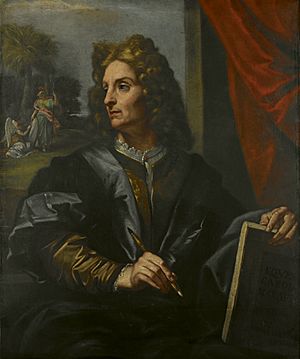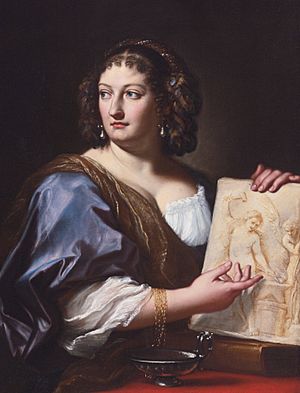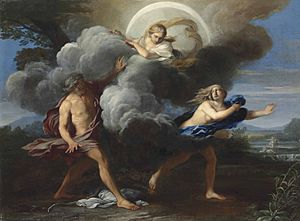Carlo Maratta facts for kids
Quick facts for kids
Carlo Maratta
|
|
|---|---|

Self-portrait
|
|
| Born | 13 May 1625 Camerano, Papal States
|
| Died | 15 December 1713 (aged 88) |
| Nationality | Italian |
| Known for | Painting |
| Movement | Late Baroque |
Carlo Maratta (born May 13, 1625 – died December 15, 1713) was a famous Italian painter. He worked mostly in Rome, a big city in Italy. He was known for his "classicizing" paintings. This means his art followed the rules of classical art, like that of Raphael.
Even though he used classical styles, he was also influenced by Baroque painting. Baroque art is known for its drama and rich colors. A friend of his, Giovanni Bellori, wrote one of the first books about Maratta's life.
Carlo Maratta's Life Story
Carlo Maratta was born in Camerano, a town that was part of the Papal States back then. When he was about 11 years old, in 1636, he moved to Rome. He went there with Don Corintio Benicampi, who worked for a powerful family.
In Rome, Carlo became a student in the art studio of Andrea Sacchi. At this time, there was a big discussion among artists at the Accademia di San Luca. This was an important art school in Rome.
Sacchi believed that paintings should have only a few figures. These figures should clearly show the story. But another artist, Pietro da Cortona, thought more figures were better. He felt more figures allowed for more detailed stories.
Maratta's early paintings were very much like Sacchi's style. They were calm and well-ordered, not as wild as Cortona's Baroque art. Like Sacchi, Maratta was inspired by great painters from other Italian cities. These included Annibale Carracci, Guercino, and Guido Reni.
Carlo Maratta and Sacchi became very close friends. They worked together until Sacchi died in 1661. Maratta's fresco, Constantine ordering the Destruction of Pagan Idols, made him noticed. A fresco is a painting done on wet plaster.
His first important independent work was Adoration of the Shepherds in 1650. Another key painting was The Mystery of the Trinity Revealed to St. Augustine.
Pope Alexander VII (who was Pope from 1655 to 1667) asked Maratta to paint many works. These included The Visitation and Nativity. He even worked under Cortona's direction for some projects. His paintings from the late 1650s started to show more light and movement. This was a mix of classical ideas and Roman Baroque art.
From 1660, Maratta started getting many private clients. These were wealthy people from all over Europe. His art studio became the most important one in Rome. After the famous artist Bernini died in 1680, Maratta became the leading artist in the city.
In 1664, Maratta became the director of the Accademia di San Luca. He wanted to make artists more respected. So, he encouraged students to study and draw ancient Greek and Roman art.
In the 1670s, Pope Clement X asked him to paint a ceiling fresco. This was for the main hall of the Palazzo Altieri. The painting was called The Triumph of Clemency. Unlike other artists of his time, Maratta did not use tricks to make his paintings look like they popped out. His scenes stayed within their frames and used fewer figures.
Some of his major works from this time include:
- The Appearance of the Virgin to St. Philip Neri (around 1675).
- The Virgin with Saints Carlo Borromeo and Ignatius of Loyola, and Angels (around 1685).
- The Assumption of the Virgin with Doctors of the Church (1686). This was for the Cybo Chapel.
Some people called him Carluccio delle Madonne, which means 'Little Carlo of the Madonnas'. This was not because he painted many pictures of the Virgin Mary. It was because he was so good at painting this theme. He also painted a large altarpiece called The Death of St Francis Xavier.
Maratta was also a well-known portrait painter. He painted many important people. These included his teacher Sacchi, Cardinal Antonio Barberini, and Pope Clement IX. He also painted a self-portrait, which is a picture of himself. Many English visitors on the "Grand Tour" (a trip around Europe) also had their portraits painted by him.
Around 1679 or 1680, Maratta had a daughter named Faustina. Her mother was Francesca Gommi. He officially recognized Faustina as his daughter in 1698. In 1700, after his first wife passed away, Maratta married Francesca. His daughter Faustina's face was used in some of Maratta's later paintings.
In 1704, Pope Clement XI made Maratta a knight. This was a great honor.
Later in his life, there was less demand for new paintings. This was partly due to money problems. So, Maratta started restoring old paintings. He worked on art by famous painters like Raphael. He also designed sculptures, such as figures of the Apostles for a church. He continued to run his art studio even when he was too old to paint himself.
Carlo Maratta died in 1713 in Rome. He was buried in the church of Santa Maria degli Angeli.
See also
 In Spanish: Carlo Maratta para niños
In Spanish: Carlo Maratta para niños
- List of Carlo Maratta pupils and assistants
Some of Carlo Maratta's Paintings
- Birth of the Virgin, 1643–1645, Church of Saint Clare, Nocera Umbra.
- Juno Beseeching Aeolus to Release the Winds Against the Trojan Fleet, 1654–1656, Ackland Art Museum, University of North Carolina at Chapel Hill.
- The Triumph of Clemency, 1673–1675, Palazzo Altieri, Rome.
- The Virgin and Child in Glory, c.1680, Spanish Royal Collection, National Museum, Madrid
- St John the Baptist Explaining the Doctrine of the Immaculate Conception to Sts Gregory, Augustine, and John Chrysostom, 1686, Cybo Chapel, Santa Maria del Popolo, Rome.
- Portrait of Clement IX Rospigliosi, 1669, Pinacoteca Gallery, Vatican Museums, Rome.
- Saint Joseph and the Infant Christ, Dunedin Public Art Gallery, Dunedin.
- Assumption of an Enthroned Virgin, Santa Maria in Vepretis, San Ginesio





